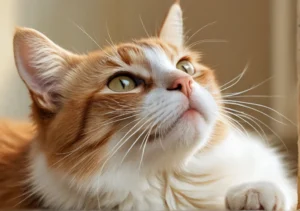Cats seem to effortlessly move with grace and agility, jumping from surface to surface, landing perfectly on their feet. Have you ever wondered why cats are more agile than dogs?
Cats are more agile than dogs due to their flexible spines, strong leg muscles, and impressive balance. Let’s explore the reasons behind their superior agility.
Flexible Spines: The Key to Cat Agility
Cats are known for their remarkable agility, and a big part of that comes down to their incredibly flexible spines. Unlike dogs, cats have an amazing ability to twist and turn their bodies in ways that seem almost supernatural. This flexibility allows them to land on their feet after falls, squeeze through tight spaces effortlessly, and move with unmatched grace and precision.
The secret lies in their spine, which is composed of multiple small bones connected by flexible joints. This unique anatomy gives cats a wide range of motion and the ability to contort their bodies in ways that dogs simply can’t match. So, the next time you marvel at your cat’s ability to squeeze into impossibly small spaces or execute a perfect backflip, remember that it’s all thanks to their incredible flexibility.
Powerful Leg Muscles: How Cats Outmaneuver Dogs
Another key factor that gives cats the upper hand in agility is their powerful leg muscles. Cats are natural-born athletes, with muscles that are specifically designed for explosive bursts of speed and incredible jumping ability. These muscles allow cats to leap great distances and heights with ease, giving them a significant advantage over dogs when it comes to agility.
Cats rely on their leg muscles to pounce on prey, climb trees with ease, and navigate complex environments with precision. Their well-developed leg muscles enable them to accelerate quickly, change direction in an instant, and land gracefully on their feet after even the most acrobatic maneuvers. It’s no wonder that cats are considered some of the most agile creatures in the animal kingdom.
Extra Tip: To help keep your cat’s leg muscles strong and healthy, provide plenty of opportunities for exercise through interactive toys, climbing structures, and regular play sessions. By keeping your cat active, you can help maintain their agility and overall well-being.
Incredible Balance: How Cats Always Land on Their Feet
Cats have a remarkable ability to always land on their feet, thanks to their incredible balance. This unique skill is attributed to their flexible spine, which allows them to twist their bodies mid-air to reorient themselves. It’s like they have an inbuilt GPS system, guiding them to a perfect landing every time they take a leap.
Moreover, cats possess a heightened sense of proprioception, which is basically knowing where their body is in space. This keen awareness enables them to adjust their movements swiftly and accurately, ensuring they land safely on their feet. So, the next time you see a cat gracefully leaping from a height, remember it’s not just luck – it’s their phenomenal balance at work!
Quick Reflexes: The Secret Weapon of Agile Cats
Another key factor that contributes to cats’ agility is their lightning-fast reflexes. These furry felines have a nervous system that is finely tuned to respond quickly to any external stimuli. Whether it’s chasing a toy or dodging an unexpected obstacle, cats can react in the blink of an eye, showcasing their impressive reflexes.
In fact, studies have shown that cats have a faster reaction time compared to dogs, allowing them to execute precise movements with speed and accuracy. This makes them adept at navigating tricky terrain, climbing trees effortlessly, and pouncing on their prey with unmatched agility. So, when it comes to agility, cats truly have the upper hand with their exceptional reflexes.
Additional insight:
Cats also have a specialized organ called the vestibular apparatus in their inner ear, which helps them maintain balance and coordination. This organ plays a crucial role in their agility, as it provides constant feedback on their position and movement, enabling them to make split-second adjustments when needed. It’s like having a built-in stabilizer that keeps them nimble and agile in any situation.
Climbing Abilities: Why Cats Are Superior Climbers
Cats are natural-born climbers, and their agility plays a massive role in their superior climbing abilities. Their flexible bodies, sharp claws, and excellent balance allow them to conquer vertical surfaces effortlessly. Unlike dogs, cats have retractable claws that help them grip onto various textures, making them adept at scaling trees, fences, or even bookshelves with grace and precision. Their keen sense of balance and coordination further enhance their climbing skills, enabling them to explore high vantage points without fear of falling.
Furthermore, cats have a remarkable vertical leap, thanks to their powerful hind leg muscles. This explosive strength enables them to jump onto platforms several times their height, showcasing their agility in navigating three-dimensional spaces. Their ability to climb not only serves as a form of exercise but also allows them to escape potential threats or predators by reaching elevated areas inaccessible to others.
To enhance your cat’s climbing experience, consider investing in a tall cat tree or a scratching post with different levels to mimic their natural environment. Creating vertical spaces indoors can satisfy their climbing instincts and provide them with mental and physical stimulation. Remember, a well-exercised cat is a happy and agile cat!
Hunting Techniques: How Agility Helps Cats Catch Prey
Cats’ agility is a crucial asset when it comes to hunting for prey effectively. Their nimble bodies and lightning-fast reflexes enable them to sneak up on unsuspecting animals with stealth and precision. Unlike dogs, who rely more on endurance and stamina during hunts, cats use their agility to stalk, chase, and pounce on their prey with calculated movements.
One unique aspect of cats’ hunting techniques is their innate ability to leap great distances in pursuit of fast-moving prey. This skill is honed through play and practice, allowing them to ambush birds, rodents, or insects with remarkable accuracy. Cats’ flexibility and sharp claws aid in swiftly capturing their target, showcasing their agility in action during the hunt.
To support your cat’s hunting instincts in a safe and controlled manner, consider providing interactive toys that mimic prey behavior. Toys that encourage stalking, chasing, and pouncing can help your cat stay mentally engaged and physically active. Remember, engaging in play sessions that stimulate their agility not only satisfies their natural instincts but also strengthens the bond between you and your feline companion.
Fun Facts About Cat Agility
Cats are known for their remarkable agility, and here are some fun facts to show you just how incredible these feline athletes are:
- Quick Reflexes: Cats have a nervous system that allows them to react quickly to stimuli, making them incredibly agile and able to land on their feet when falling.
- Flexible Spines: Cats have a highly flexible spine with up to 53 vertebrae, compared to a dog’s 34, enabling them to twist and turn with ease.
- Muscle Power: Their muscles are designed for explosive bursts of energy, giving them the ability to jump several times their body length in a single bound.
- Balancing Act: Cats have a unique inner ear structure that helps them maintain balance and coordination, essential for their agile movements.
- Natural Instincts: Cats are natural hunters and climbers, which contribute to their agility as they navigate various terrains with ease.
Impressed by these impressive feline feats? Now let’s see if agility training can help your furball reach their full potential!
Agility Training for Cats: Can It Be Done?
Contrary to popular belief, agility training isn’t just reserved for dogs! With some dedication and patience, you can teach your cat some impressive agility skills to keep them mentally and physically stimulated. Here are some top tips to get started:
- Start Small: Begin with basic commands like “sit” and “jump” using treats as rewards to encourage your cat to follow your cues.
- Obstacle Course: Set up a simple obstacle course at home using tunnels, hoops, and platforms for your cat to navigate through.
- Consistency is Key: Practice regularly in short sessions to keep your cat engaged and motivated to continue learning.
- Positive Reinforcement: Reward good behavior and ignore any undesired behaviors to reinforce positive habits.
- Patience is a Virtue: Remember, not all cats will take to agility training right away, so be patient and understanding of your cat’s individual pace.
By engaging in agility training, you can enhance your cat’s physical abilities while providing mental stimulation and strengthening your bond. Give it a try and watch your cat turn into a true agility champion!
Conclusion: The Enduring Agility of Cats
Cats have been revered for their agility for centuries, and it’s no wonder why. Their flexible bodies, powerful muscles, and keen sense of balance set them apart from other animals, including dogs. Cats can effortlessly leap to great heights, balance on narrow ledges with grace, and maneuver through tight spaces with ease. It’s a combination of their genetic makeup and natural instincts that make them such agile creatures.
One unique aspect of a cat’s agility is their retractable claws. Unlike dogs whose claws are always extended for traction, cats can retract their claws when navigating tricky terrain, allowing for better balance and precision in their movements. This evolutionary adaptation gives cats a significant advantage when it comes to agility, enabling them to move swiftly and gracefully across various surfaces.
In addition to their physical attributes, cats possess exceptional reflexes and quick decision-making skills. This allows them to react swiftly to changes in their environment, such as sudden movements or obstacles in their path. Cats are masters of spatial awareness, able to calculate distances accurately and adjust their movements accordingly, making them proficient hunters and skilled climbers.
Overall, the enduring agility of cats stems from a combination of their unique anatomy, innate instincts, and exceptional athleticism. Whether they’re leaping from high places, chasing prey, or simply navigating their surroundings, cats continue to captivate us with their impressive agility that sets them apart from other animals.
Alex, a passionate animal lover, has experience in training and understanding animal behavior. As a proud pet parent to two dogs and three cats, he founded AnimalReport.net to share insights from animal experts and expand his knowledge of the animal kingdom.




